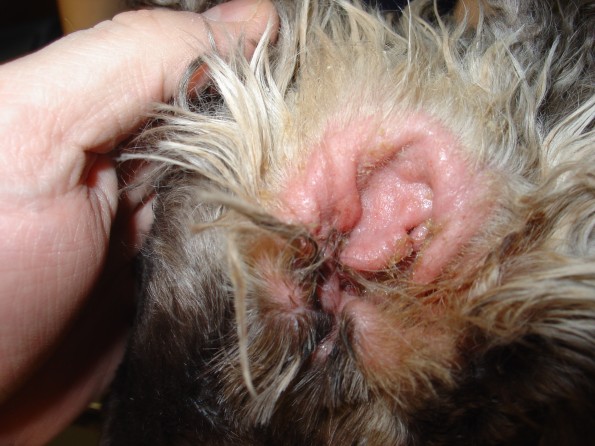
Ear infections are one of the most common problems we see in dogs. Ears usually flare up from allergies or parasites like ear mites. Yeast and bacteria may overgrow when the ears are inflamed and make the ears itchier. Moist environments can make the problem worse, as seen in dogs with long floppy ears, or dogs that have narrow ear canals with lots of hair growth inside the ears.
Dogs with ear infections have characteristic signs. They will scratch at the infected ear more than normal. They often shake their head vigorously. There is typically an increase in production of dark brown wax and the ears can have a foul or ‘yeasty’ odor. The affected ear has thicker than normal skin and is dark pink to red in colour. Your dog may seem painful when the ear is touched.
Most ear infections can be cleared with medicated drops and cleaning the wax as needed. The type of medication used depends on the type of ‘bugs’ within the ear and your veterinarian will likely want to do a ‘cytology’ test to determine this.
In some cases ear infections continue to come back despite appropriate treatment. Our case of the week is one of such cases.
“Roxie” came earlier this month for a third time in a year with pain and infection in the right ear. The ear was very sore when examined and noted to have ulcers inside the ear canal. After testing the ear, I noted different bacteria under the microscope than is commonly seen in ear infections. A culture sample was taken so that the bacteria in the ear could be identified.
The culture showed that Roxie was positive for Pseudomonas aeruginosa. This is a particularly nasty type of bacteria that causes more severe, painful ear infections. It is resistant to many antibiotics and requires non-traditional ear medication to clear the infection.
I prescribed an antibiotic ear flush specifically for this bacterial infection to be used twice daily. After 2 weeks Roxie’s ear was much more comfortable and the ulcers had healed!
Does your dog suffer from ear infections? We can help find the right medications to treat the problem. To manage costs of diagnosing and treating ear infections, culture tests are not always done. However, if your dog’s infection just doesn’t seem to go away, it might be time to do a culture test!



